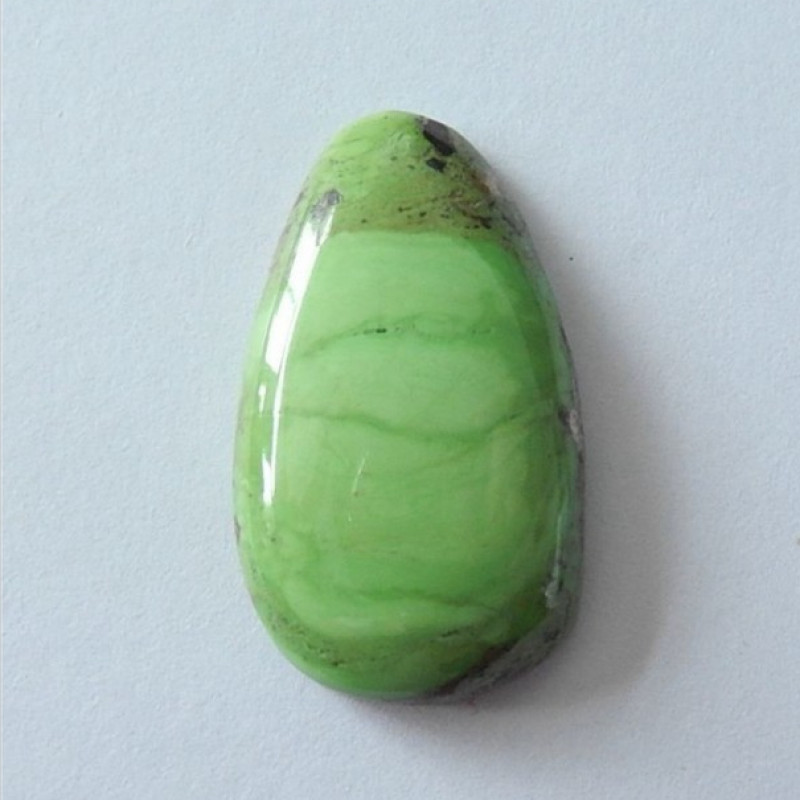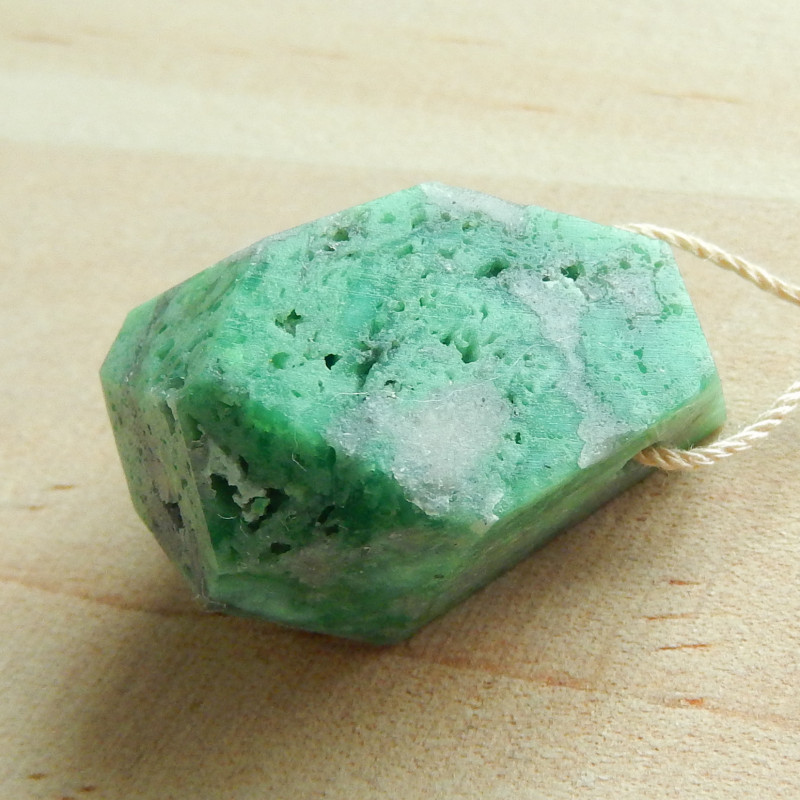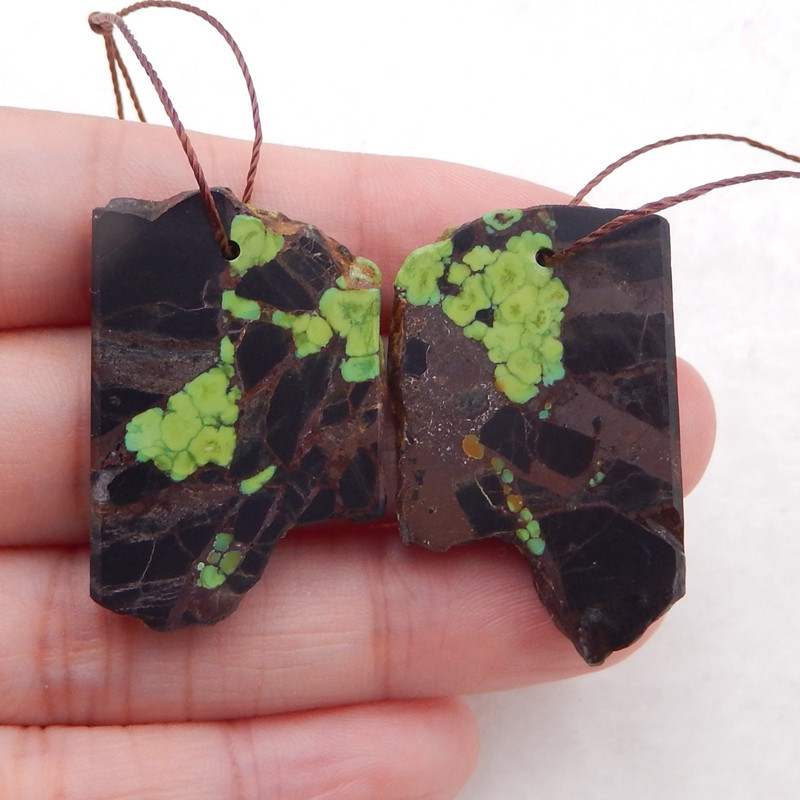Gaspeite Gemstone: Properties, Meaning, Value & Healing Uses
 Gaspeite (gasp-ee-ite) is a brightly colored yellow to green gemstone related to calcite. It’s also spelled gaspéite, paralleling the different spellings of the gem’s first source: the Gaspe (or Gaspé) Peninsula in Canada.
Gaspeite (gasp-ee-ite) is a brightly colored yellow to green gemstone related to calcite. It’s also spelled gaspéite, paralleling the different spellings of the gem’s first source: the Gaspe (or Gaspé) Peninsula in Canada.
This isn’t the only stone we can thank the Great White North for — other gemstones first discovered in Canada include ammolite, labradorite, and the extremely rare poudretteite.
Speaking of, is gaspeite stone rare? Yes, gaspeite is rare, only mined from a few locales, with only two significant deposits currently. It’s also not well-known and has only started gaining popularity in recent times.
Is your interest piqued? Come along to learn everything about gaspeite properties, jewelry, healing powers, and more!

What Is Gaspeite Gemstone?
Gaspeite is a commonly apple-green semi-precious gemstone beloved for intricate carvings. It has brown veining or splotches, making it resemble green turquoise.
As a turquoise simulant, gaspeite can substitute in place of this traditional December birthstone. Those born under Virgo are graced with a gaspeite zodiac stone.
One trade name for gaspeite is “Allura,” though it’s not common.
Some stones in a series with gaspeite (discussed next) often have trade names with “lemon” or “citron” before “magnesite” or “chrysoprase” — though chrysoprase is a separate stone.
Besides ornamental and gemstone uses, gaspeite is a minor source of nickel.
Gaspeite Specifications & Characteristics
The mineral gaspeite is a nickel carbonate (NiCO3). However, the more accurate chemical formula is (Ni,Mg,Fe)CO3, as it’s almost always found with magnesium and iron replacing part of its nickel content.
Gaspeite is in the calcite mineral group, which encompasses similar carbonates that form a solid solution series — meaning they share the same crystal system and base formula, but each one has different elements substituted in their individual formula.
In the entire calcite solution series, gaspeite represents the nickel-rich portion.
Magnesite (magnesium carbonate) is closely related, forming a smaller solution series with gaspeite and siderite (iron carbonate). Minerals with varied amounts of these elements are “intermediate” members and make popular jewelry stones.
Here are all the gaspeite properties:
Mohs hardness: 4.5-5
Color: Yellow, yellow-green, or bright green; Usually brown patterns
Crystal structure: Trigonal
Luster: Dull to vitreous (glassy)
Transparency: Translucent (crystals); Opaque (masses)
Refractive index: 1.61-1.83
Density: 3.71-3.91 (denser with higher nickel content)
Cleavage: Good, 1-direction on [1011] (crystals)
Fracture: Uneven/Irregular
Streak: Yellow-green
Luminescence: Not fluorescent naturally; Resin-coated stones often fluoresce strongly - light blue and bright green under SW-UV & LW-UV
The specifications between crystals and masses in the list above has to do with the various forms gaspeite can take.
How Do You Identify Gaspeite?
There are a few ways to distinguish gaspeite from other minerals. For one, you can look for one of its crystal habits:
Crystal aggregates (multiple visible crystals grown together)
Compact, radiating crystal clusters with kidney-shaped terminations
Cryptocrystalline (compact with crystals too small to distinguish)
Botryoidal concretions (rounded masses resembling grape clusters)
Lumpy masses filling rock fractures
However, these shapes exist in other gemstones. More precise identification tests include:
Color: Look for a bright green or yellow-green base with light brown inclusions.
Effervescence: With a rough specimen, you can scratch it against a streak plate to produce powder. Then, drop a solution of water and hydrochloric acid (5 percent) onto the powder and look at it closely. True gaspeite will show bubbles forming.
Refractive Index: With a Refractometer, look for a reading between 1.61 and 1.83. Rotating a polaroid plate in front of the refractometer (with the stone below) should cause a “birefringence blink” where the refractive-index shadow on the stone appears to jump.
 Pictured: Turquoise
Pictured: Turquoise
Gaspeite vs. Green Turquoise
Many confuse gaspeite with greener turquoise stones. However, there are important distinctions between the two:
Hardness: Gaspeite is slightly softer than turquoise, which has 5-6 hardness.
Density: Gaspeite’s density is significantly higher than the 2.6-2.8 density of turquoise.
Color: Undertones are bluer in turquoise and more yellow in gaspeite.
You’ll often see gaspeite and turquoise together in Southwestern jewelry. Southwestern-style jewelry originates from traditional Native American designs and usually incorporates elements like leather, sterling silver, and inlay designs.
Some organic gems like coral and jet are also common in Southwestern jewelry. Modern designs may incorporate lapis lazuli or tiger’s eye.

Gaspeite Meaning & History
Interpretations of gaspeite’s spiritual meaning tie to spirituality, protection, and releasing the past. Among indigenous Australian tribes, gaspeite is a lucky talisman used to facilitate the spiritual, sometimes out-of-body experiences anthropologists call “vision quests.”
Wait, is gaspeite from Australia? Yes, gaspeite comes from Australia, though it wasn’t the first source.
The discovery of gaspeite happened in 1966 at the Gaspe Peninsula (near the Saint Lawrence River) in Quebec, Canada. Members of the New Jersey Zinc Exploration Co. Ltd. made the discovery.
Mineralogy researchers J.L. Rodda and D.W. Kohls published a description of the new mineral and its name in the 1966 edition of American Mineralogist.
In the 1970s, gaspeite was used for various Southwestern jewelry, particularly on Native American reservations. The stone remained largely unknown outside of these groups until the 1990s, particularly in 1994 when it featured in jewelry at the annual Gem and Mineral Show in Tucson, Arizona, USA.
Gaspeite also features in various crystal healing collections, but what does it do?

Gaspeite Healing Properties
All gemstones can possess properties as healing stones based on their colors and energies. Like other yellow gems, yellow gaspeite inherently represents joy, intelligence, and hope. Green gaspeite crystal healing similarly ties to the widespread green gem uses of connecting to nature, providing balance, and promoting optimism.
Since most gaspeite crystals have yellow and green tones, they can all be used as chakra stones for both the heart chakra (green) and solar plexus chakra (yellow).
What about gaspeite uses for physical and emotional healing?
Physical Healing
As a newer stone, not many healing properties have been attributed to gaspeite yet. The stone is said to lower stress, aid with weight loss, and help with diseases of the heart or lungs.
Emotional Healing
Gaspeite is said to facilitate self-healing from deep emotional wounds. Crystal healers believe the stone gives you the courage to face the issues head-on while protecting you from being consumed by the powerful emotions. From there, gaspeite purportedly helps you process the pain and start healing.

Gaspeite Gemstone Properties
Browsing for your own gaspeite stone for sale? First, you’ll want to know what value factors (or gemstone properties) to look for.
Gaspeite is commonly cut into large finished stones, so carat weight doesn’t play a significant role in gaspeite value. The factors that do play a role are color, cut, and treatments.
Color
Gaspeite can display many shades of green, but the most common are yellow-green, grass-green, and olive. It’s almost always found with brown veining or mottling, whether the base color is yellow or green.
Both colors are caused by the amount of nickel in the stone, while the brown portions are leftover portions of the rock gaspeite formed inside.
Stones with more saturated or uniform coloring carry higher value.
Cut
Gaspeite’s low Mohs hardness scale ranking makes it ill-suited for faceted cuts. The material is great for carvings, cabochons, and beads, all of which make gorgeous gaspeite jewelry like pendants or bracelets.
Other common cuts for gaspeite or intermediate gaspeite-magnesite materials are tumbled stones and inlay work. Pieces with more intricate craftsmanship command higher prices.
Treatments
Because gaspeite is a soft gem, some jewelers apply a coating treatment to make the stone stronger and more wearable. This coating is often a form of resin and can make the stone appear fluorescent, despite natural gaspeite lacking fluorescence.
Resin-treated gaspeite looks glossier than untreated gaspeite. Like most gems, treatments will lower gaspeite’s value.

Gaspeite Formation & Sources
Most gaspeite forms as a secondary mineral, or a mineral that forms due to the rock around it being changed by outside forces. Intense exposure to natural forces (weathering) is usually the cause.
Miners find gaspeite in nickel-rich deposits, usually inside rocks like siliceous dolomite or kambaldaite. Some scientists theorize South African gaspeite formed when nickel-rich meteorite transformed.
Speaking of locations, where are gaspeite minerals found?
Mining Locations
Though the first source, Canada, still produces gaspeite, the majority of this mineral currently comes from Western Australia.
Minor amounts come from:
Greece
Italy
Japan
New Mexico, USA
South Africa
Will the price of gaspeite make you gasp? Probably not, but we’ll go over prices next!
Gaspeite Price & Value
Despite its rarity, gaspeite is a pretty affordable gemstone! At wholesale, cabochons range from $0.50 per carat to just under $2.50 per carat.
Rough specimens have a broader range, from $0.15 to $5 per carat. Lastly, gaspeite beads are the highest (though still inexpensive) at $0.80 to $2 per carat, though the highest-quality pieces reach $5.50 per carat.

Gaspeite Care and Maintenance
Choosing safer jewelry is the first step for gemstone care. Pendants, earrings, and pins are less vulnerable to damaging impacts. You can still wear a gaspeite ring, but we recommend one with tall protective settings.
For multi-gemstone beaded jewelry, choose gems with similar hardness to gaspeite (like apatite) or have separations between the beads so they don’t touch.
Gaspeite has fairly low hardness and good cleavage, so it can split and scratch pretty easily. Additionally, it’s sensitive to acids, so proper cleaning and storage should keep it away from these types of chemicals.
Wondering how to safely clean gaspeite? Use a soft, dust-free cloth that’s slightly damp to gently wipe down the surface. Pat it dry with a similar but dry cloth.
Store gaspeite in a velvet pouch or fabric-lined container away from other gems.
Enjoy Glitz and Glam with Gaspeite!
Since the 1990s, gaspeite has seen a slow but steady rise in popularity. Still, most people have never heard of this bright little gem, and scientists have more to discover about it. This makes gaspeite even more exceptional, perfect for anyone just as alluring and unique as the crystal itself!
Was this article helpful?
Ross Sedawie
- Written - 15th Jul 2022
- Edited - 21st Dec 2023

















